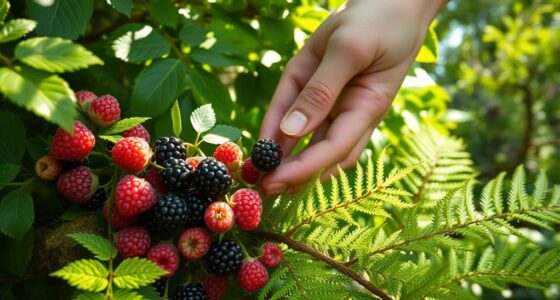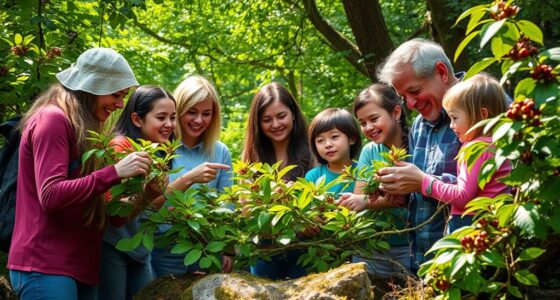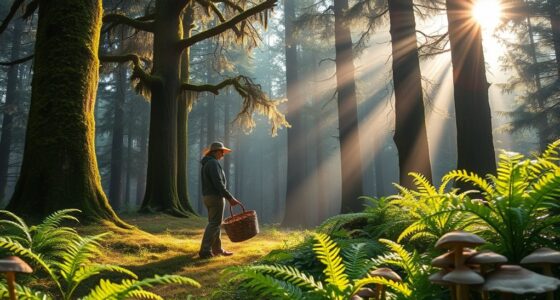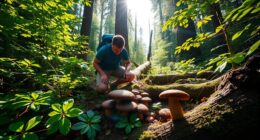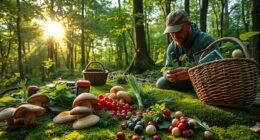As climate change shifts seasons, you should adjust your foraging practices accordingly. Stay aware of earlier springs, later falls, and new plant and animal migration patterns, as these changes impact what’s available and when. Use seasonal guides, community insights, and flexible strategies to adapt your harvesting to these evolving conditions. Embracing sustainability and traditional knowledge can help you thrive despite ecological shifts—continue exploring how to stay resilient amid these transformations.
Key Takeaways
- Climate change causes earlier springs and later autumns, requiring foragers to adjust timing and seasonal expectations.
- Shifting plant phenology and migration patterns demand updated knowledge and flexible foraging strategies.
- Monitoring environmental changes and using remote sensing tools help identify new or altered food sources.
- Community collaboration and knowledge sharing enhance adaptive practices and sustainable harvesting amid ecosystem shifts.
- Diversifying foraging locations, including urban areas, increases resilience to changing seasonal patterns.
Understanding the Effects of Climate Change on Seasonal Patterns
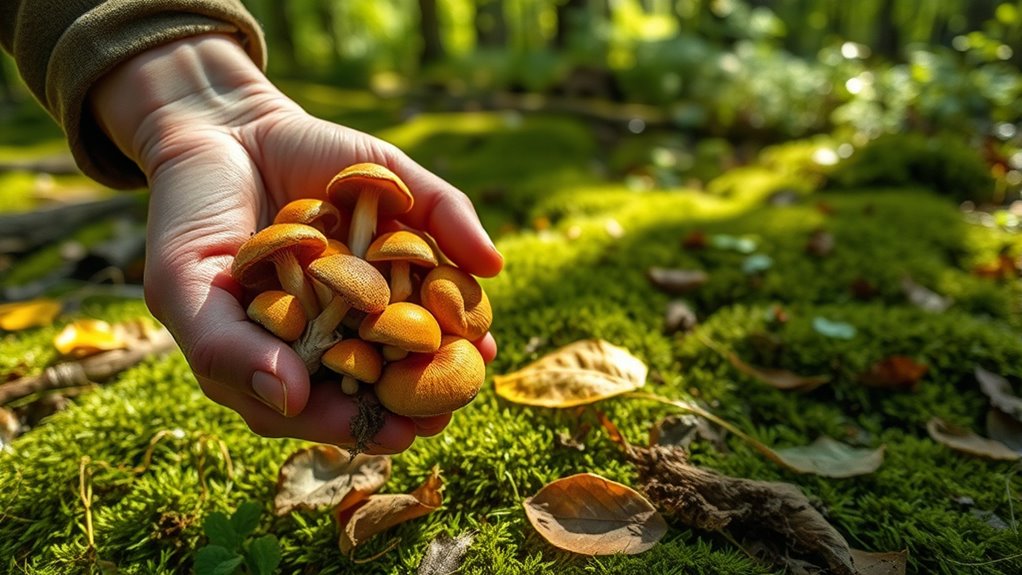
Climate change directly impacts seasonal patterns by altering the timing and duration of key ecological events. Over the last thirty years, you’ve seen the growing season extend by about a month, with spring arriving roughly two weeks earlier and autumn starting two weeks later. Rising temperatures cause plants to grow longer, increasing their vulnerability to diseases and drought. These shifts vary by region, with more noticeable changes in the northern hemisphere. You might notice earlier snowmelts, altered migration timings, and disrupted flowering cycles. These changes don’t just affect plants—they influence entire ecosystems and local weather. As seasons stretch or shift, the natural rhythm you’re accustomed to becomes less predictable, presenting challenges for both wildlife and human activities. Additionally, the rise in cyber threats underscores the importance of adaptive strategies in various sectors to mitigate emerging risks. Recognizing these shifts, many researchers are emphasizing the need for ecological monitoring to better understand and respond to changing seasonal dynamics. Implementing comprehensive monitoring systems can help detect early signs of ecological disruptions and inform conservation efforts. Furthermore, advancements in climate modeling are essential for predicting future seasonal shifts and preparing effective responses. Understanding the long-term effects of climate change on ecosystems is crucial for developing sustainable adaptation strategies.
Identifying Shifts in Local Flora and Fauna

Changes in seasonal timing and ecological events have led to noticeable shifts in local flora and fauna. You can observe plants blooming earlier or later than usual, driven by rising temperatures and altered rainfall patterns. Monitoring programs and remote sensing tools help detect these changes in vegetation distribution and health. Incorporating good lighting in environmental monitoring sites can improve the accuracy of observations and data collection. Invasive species, outcompeting native plants, further modify ecosystems, making it vital to track their spread. Animal migration patterns also shift, with many species moving to higher latitudes or elevations in response to warming. Marine species migrate northward faster than land animals, disrupting local food chains. Citizen science initiatives and scientific surveys provide valuable data, allowing you to identify these shifts. Recognizing changes in local flora and fauna helps you understand broader ecological impacts and informs adaptive strategies. Additionally, understanding phenological shifts can help predict future environmental changes and guide conservation efforts. To enhance data accuracy, integrating predictive analytics can be particularly effective in modeling future ecological responses.
Strategies for Adapting Foraging Practices to Changing Seasons

As seasonal patterns shift, it becomes essential for foragers like you to adapt your practices to stay successful and sustainable. Embrace seasonal guides to plan trips during peak times, like late summer for abundance or winter for hardy plants.
Adjust your focus to spring greens such as dandelions and fall nuts and seeds, aligning your harvest with wildlife activity. Be flexible and prepared for unpredictable weather, which may alter plant availability.
Learn to identify new or shifting flora caused by climate change by staying updated with digital guides and community insights. Maintaining a mindset of abundance and respect for ecosystems helps avoid overharvesting.
Use weather alerts and seasonal maps to optimize your outings, ensuring your foraging remains effective and responsible in changing conditions. Additionally, staying informed about forage 100 and related resources can help you better understand the evolving landscape and adapt your practices accordingly.
Being aware of foraging ranges can help you plan your foraging trips more effectively, especially as environmental conditions evolve.
Furthermore, understanding climate change impacts on ecosystems can enhance your ability to anticipate shifts in plant distributions and availability.
Incorporating knowledge about nutritional value of local plants, such as the presence of high-fiber or antioxidant-rich species like chia seeds, can also improve the sustainability and healthiness of your foraged foods.
The Role of Sustainable Harvesting in Climate Resilience
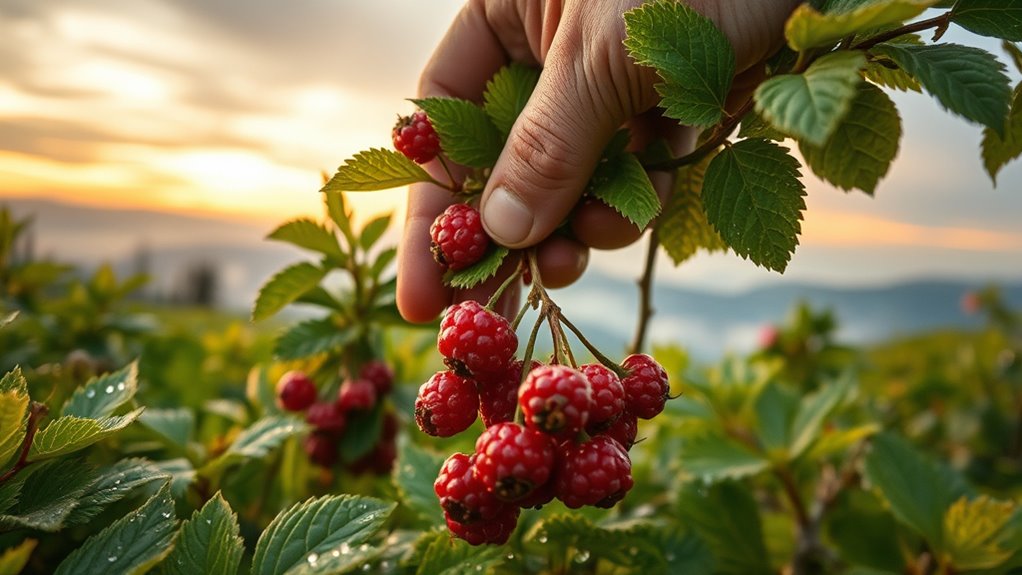
Sustainable harvesting plays a crucial role in building climate resilience by maintaining ecosystem balance and protecting biodiversity. When you adopt sustainable practices, you help prevent overexploitation of natural resources, ensuring ecosystems remain healthy and productive. Implementing cost-effective solutions like efficient resource management can further enhance these efforts. This approach minimizes waste and boosts resource efficiency, which is essential as climate change causes unpredictable weather and resource scarcity. Incorporating self-watering plant pots as part of sustainable gardening practices can reduce water use and promote healthier plant growth, further supporting ecosystem sustainability. Understanding ecosystem vulnerabilities and their complexities allows for tailored strategies that adapt to changing environmental conditions. Additionally, leveraging energy-efficient heating methods in agricultural and horticultural practices can support sustainable resource use in various climates. Recognizing the importance of market trends in sustainable agriculture can help optimize resource allocation and investment. To succeed, you need to understand local ecosystems and their vulnerabilities, working closely with policymakers and scientists to develop effective guidelines.
Community Collaboration and Knowledge Sharing for Adaptive Foraging

Community collaboration and knowledge sharing are essential for adaptive foraging in the face of climate change. By engaging community members through local initiatives, you can learn about climate impacts and develop resilient practices.
Partnering with schools introduces young people to sustainable foraging and climate awareness early on. NGOs and government programs provide resources and support, while partnerships with local businesses promote sustainable harvesting.
Sharing traditional knowledge among indigenous communities and across regions enhances resilience. Community forums, workshops, and digital platforms facilitate exchanging best practices and real-time information. Incorporating traditional foraging techniques and understanding seasonal shifts can further improve community resilience and sustainable practices. Additionally, understanding the environmental impact of various foraging methods can help communities choose more sustainable options.
Collaborations between farmers, researchers, and policymakers help integrate scientific insights into local practices. Including marginalized groups and empowering women and youth ensure equitable participation, strengthening the overall adaptive capacity of foraging communities. Building community resilience is vital for navigating the uncertainties of climate change and ensuring sustainable food sources for future generations. Additionally, emphasizing seasonal awareness can help communities adapt their practices more effectively to changing environmental conditions. Promoting adaptive strategies can further enhance community responsiveness to unpredictable climate patterns.
Future Perspectives: Embracing Flexibility in Foraging Knowledge
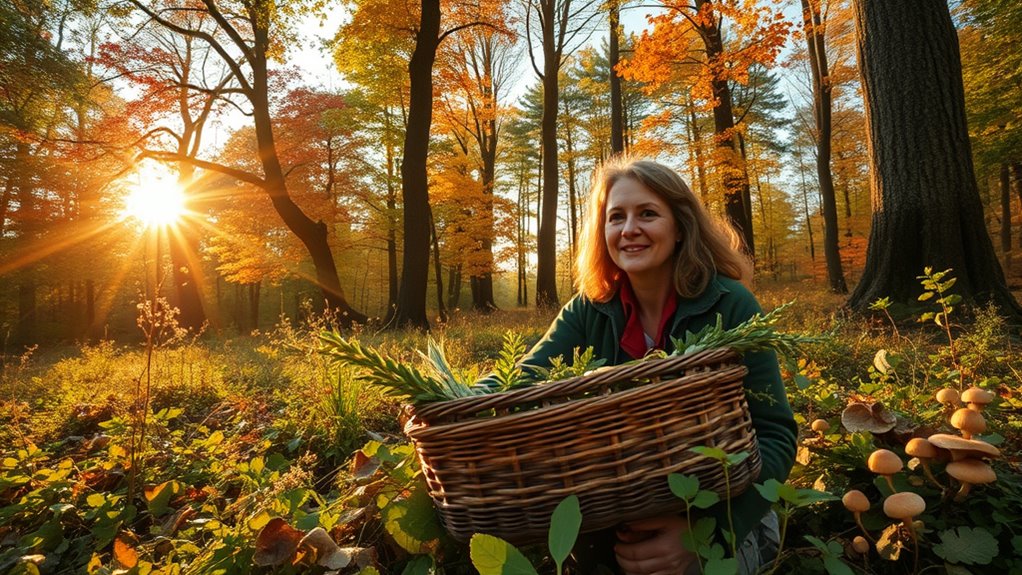
Recognizing the importance of integrating diverse knowledge systems, embracing flexibility in foraging knowledge becomes essential as ecosystems shift under climate change. You need to adapt by continuously updating your understanding of plant phenology, distribution, and new species arrivals. Crisis FAQs Staying observant of environmental changes allows you to adjust foraging locations and timing, moving beyond fixed seasonal expectations. Expanding your perspective to include overlooked landscapes and urban environments diversifies your foraging options and strengthens your adaptability. Incorporating space optimization techniques can help manage resources efficiently in changing environments, ensuring sustainable practices that protect both cultural traditions and ecosystem health in a changing climate.
Frequently Asked Questions
How Can Foragers Contribute to Local Climate Change Mitigation Efforts?
You can contribute to local climate change mitigation by practicing sustainable foraging. Focus on diversifying your forage, supporting local ecosystems, and minimizing soil disturbance.
Identify climate-resistant species and adapt your foraging seasonally. Share knowledge with your community, participate in workshops, and collaborate with conservation groups.
Your efforts help preserve biodiversity, enhance soil health, and promote carbon sequestration, all of which support broader climate resilience and reduce greenhouse gases.
What Are the Legal Considerations for Foraging in Changing Environments?
You might think legal considerations don’t change, but they do, especially as environments shift. You need to stay aware of local, state, and federal rules, which can conflict or update.
Always check if permits are required, respect protected areas, and follow sustainable practices. By understanding and adhering to these legal boundaries, you help ensure your foraging remains ethical, safe, and environmentally responsible in changing environments.
How Does Foraging Impact Native Plant Conservation During Climate Shifts?
You should understand that foraging impacts native plant conservation by influencing ecosystem health and biodiversity. When you practice sustainable foraging, you help reduce habitat disruption, control invasive species, and promote native plant growth.
During climate shifts, adaptive foraging supports resilience by minimizing stress on native plants, conserving soil and water resources, and maintaining ecological balance. Your mindful approach can play a vital role in safeguarding native plant populations amid changing environmental conditions.
Can Traditional Ecological Knowledge Help Predict Future Seasonal Changes?
You can see that traditional ecological knowledge helps predict future seasonal changes by observing natural signs like animal behaviors, plant cycles, and weather patterns. You rely on these cues passed down through generations, which offer valuable insights often overlooked by modern science.
Combining these observations with scientific methods enhances your ability to anticipate shifts, improve preparedness, and adapt more effectively to changing seasons in your environment.
What Technological Tools Assist in Adapting Foraging to Unpredictable Weather Patterns?
You seek tools to adapt to unpredictable weather, and technology offers powerful solutions. Soil sensors help you monitor moisture and temperature, guiding your foraging timing.
Advanced weather forecasting provides accurate predictions, while remote sensing tracks habitat changes.
Decision support systems give you real-time insights, and climate information services help you plan effectively.
Conclusion
As seasons shift and skies grow unpredictable, you stand at the edge of a changing world, your senses attuned to the dance of flora and fauna. By embracing flexibility and sharing knowledge, you weave a resilient tapestry of foraging, rooted in sustainability. Like a gentle breeze guiding you through unfamiliar landscapes, your adaptability ensures you’ll continue to harvest nature’s bounty, thriving amid the ebb and flow of a warming Earth.




